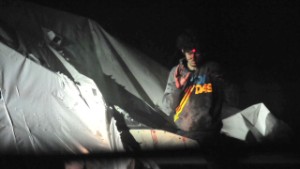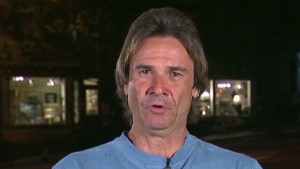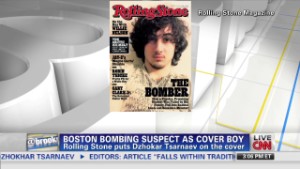- David Weinberger says he's not outraged about the Rolling Stone cover
- He asks, why must we prove bombings upset us before we can discuss not minding cover?
- He says cover assumes that we all agree bombings were an act of a monster
- Weinberger: Cover confronts the mystery of someone like us who came to hate us
Editor's note: David Weinberger is a senior researcher at the Harvard Berkman Center for Internet & Society and author of "Too Big to Know" (Basic Books).
(CNN) -- I know I'm supposed to be outraged by the Rolling Stone cover that depicts Dzhokhar Tsarnaev as a dreamy young man, with its implicit resonances with the famous Jim Morrison photo. When taken with the words that overlay it, the photo presents a mystery that we need to explore. So, I am not outraged. In fact, I am discouraged by the outrage itself.
I feel obligated to begin by stating that I have no sympathy for a murderer of children, that I was horrified by such actions, and that I feel deeply for the Boston bombing's victims. I live in Boston and have written about the sense of solidarity Bostonians felt after the attack, and especially on the day we sat still so that suspects could be tracked and caught. I rooted for Tsarenaev's capture, and I hope the alleged killer spends a long time miserable in jail, after a fair trial, of course.
But the very fact that we have to gain entry to the conversation by stating our bona fides like this disturbs me. Culture is based on shared values and beliefs. Having to state that you're against the killing and maiming of families and the loved ones they were cheering on creates a rift where there isn't one, as if this value were not a settled part of what binds our culture. Could we even come up with a stance that more quickly and surely means that you're not a part of the lives we share together?

The Rolling Stone cover correctly assumes that there is no such rift. It assumes that of course we all hate what the Tsarnaev and his older brother, the late Tamerlan Tsarnaev, are accused of doing (Dzhokhar Tsarnaev has pleaded not guilty to federal charges in connection with bombings). The words on that cover state what many of us — the "us" that covers our culture — believe: He was a bomber. There isn't even an "alleged" there, and the premise of the article stated on the cover also denies that qualifier: "How a popular, promising student was failed by his family, fell into radical Islam and became a monster." In case you were unclear about where Rolling Stone stands on Dzhokhar Tsarnaev, the words "bomber" and "monster" should make it clear.
But you shouldn't be unclear. That's why we have a culture -- a shared set of values and beliefs.
The words are not causing the outrage that the photo has engendered. But when taken with the words, the angelic photo makes exactly the point that needs to be made and that our Culture of Outrage obscures.
When a terrorist was raised in a foreign land, and especially when to the mainstream the terrorist looks foreign and repellent — for example, the photo of an unkempt, grim Khalid Sheikh Mohammed that has become so iconic that it's even used at Wikipedia, a site that takes a "neutral point of view" as its mantra — we feel safe in simply assigning the person to a category. "He's a terrorist," we say, as if that were a biological species that completely explains the person. Such categories shut down thought. They block understanding. Terrorist? 'Nuf said.
 Officer releases pics of 'real' Tsarnaev
Officer releases pics of 'real' Tsarnaev  Tlumacki on 'poster boy for terror'
Tlumacki on 'poster boy for terror'  Boston Bombing suspect as cover boy
Boston Bombing suspect as cover boy But it's not enough. Understanding is important not only so that we can help prevent the sort of despicable Boston Marathon bombers and the KSMs of our fractured world, but also so we can see our human species — and thus ourselves — more clearly.
The cover photo of Dzhokhar Tsarnaev taken with the stark words overlaying it speak to the mystery that was laid bare when the brothers were first identified. The media turned to his friends, interviewing young men and women who were profoundly shocked that someone they knew as helpful, warm, and open to diversity could be accused of so deeply betraying their values. I felt like I knew many of those friends, for they were so like our children and the children they know.
That was the mystery that was presented to us when the Tsarnaevs were identified not only as murder suspects, but as a threat to the humane innocence that is the heart of American culture.
We need that mystery explored. To counter our natural desire to think that those who attack us so vilely must be totally unlike us, we need not only the words denouncing them, but images that reminds us that they weren't born as what they became. This juxtaposition makes the mystery manifest: Someone like us became someone who hates us.
We need to explore that mystery not so we can sympathize with a despicable accused murderer but so we understand better how he passed beyond sympathy. The cover of Rolling Stone -- words and picture -- puts that awful mystery right in front of us.
But we seem to prefer the security of outrage.
Follow @CNNOpinion on Twitter.
Join us at Facebook/CNNOpinion.
The opinions expressed in this commentary are solely those of David Weinberger.
via CNN.com - Top Stories http://rss.cnn.com/~r/rss/cnn_topstories/~3/6YLlF_wMjyI/index.html
No hay comentarios:
Publicar un comentario